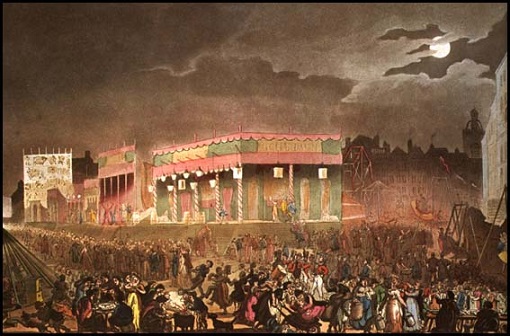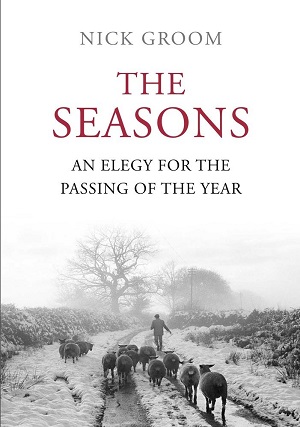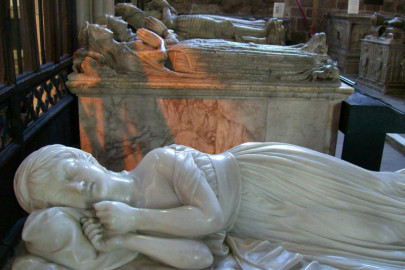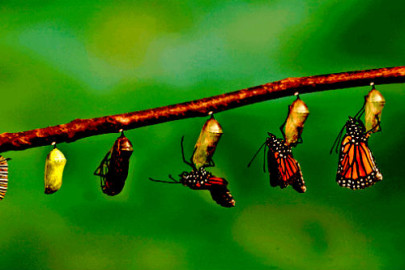Forget Glastonbury and the Notting Hill carnival – the Bartholomew Fairs of old would have dwarfed them, and far outdone them for debauched behaviour too. For his August post, Prof Nick Groom looks at England’s history of late summer fairs…
The end of harvest in England was usually celebrated in the last week of August with church wakes, public entertainment, and enthusiastic drinking – as imagined in the late fourteenth-century poem Piers Plowman through the allegorical figures of Gluttony and Hunger:
By that it neghed neer harvest and newe corn cam to chepyng;
Thanne was folk fayn, and fedde Hunger with the beste –
With good ale, as Gloton taghte – and garte Hunger to slepe.
This helps to account for the rise of St Bartholomew’s Day Fair, which usually commenced on or around 24 August. It was the crowning event of the summer season. Fairs were held throughout the late summer and early autumn, often on feast days – among them St Barnabas’ Day, Lammas-tide, Mary’s Nativity, the feast of the Exaltation of the Holy Cross, and St Matthew’s Day. Fairlop Fair was a huge fair held in July that was centred an ancient oak tree in Epping Forest; the tree was eventually blown down in 1820 and some of the wood was used to make the pulpit and reading desk of St Pancras Church on London’s Euston Road. Scarborough Fair, established in 1253, began on 15 August and at its height lasted for a staggering forty-five days. It too came to an end in the nineteenth century. Many other local and regional fairs have disappeared, and with them have gone local history, identity, and customs. This is in part due to the long decline of English agriculture, which has inevitably reduced the frequency and size of fairs. Common land has been enclosed and traditional grounds have been built over, thus removing possible sites. The Reformation also played its part by trying to insist that all parishes held their annual fairs or festivals on the first Sunday in October. Most significantly, though, there were radical changes in the seasonal rhythm of work. The move from an agrarian economy, where periods of intense activity such as the harvest were followed by others of relative idleness, to the regular factory working hours of the Industrial Revolution – and very long hours at that – meant that there was simply no longer any time to attend the great fairs.
The archetypal English August Bank Holiday event today is probably London’s Notting Hill Carnival, which has been running since 1965: it is a huge and dazzlingly diverse annual event – only Rio’s Mardi Gras is bigger. Open-air music festivals have also relentlessly gained in popularity, the most established being the Reading Festival (formerly Reading Rock) which also happens to take place over the August Bank Holiday weekend. Reading Festival was established in 1971 as ‘The National Jazz, Blues, and Rock Festival’; it was banned for two years in 1984-5 and is now twinned with the Leeds Festival. (I still have a t-shirt from the 1983 festival emblazoned with the lament ‘The Last Reading Rock’; I was there again when it was resurrected in 1986.)
Notting Hill Carnival and greenfield music festivals such as Glastonbury may be the most popular seasonal gatherings of twenty-first-century England, but they are dwarfed by past events such as St Bartholomew’s, or Old Bartlemy’s, Fair. This was the most famous – or notorious – of the annual fairs. It began in 1133 as a three-day cloth fair held the churchyard of St Bartholomew the Great, West Smithfield. But as London grew so did Bartholomew Fair, and it became a huge event in the city streets, not least because it was hard by Cock Lane with its many blandishments in the shape of brothels and bawdy houses. Old Bartlemy’s gradually drew fringe events, from dogs that danced the Morris to re-enactments of St George slaying the dragon to public executions: Bartholomew Fair was where the Scottish rebel Sir William Wallace was executed in 1305 by being hanged, drawn, and quartered, and subsequently Reformation and then Counter-Reformation martyrs were burnt there too. Notwithstanding such endorsements from the state, the Puritan Richard Brathwait nevertheless attacked the event in 1631 for moral turpitude:
No season through all the yeere accounts hee more subject to abhomination than Bartholomew faire: Their Drums, Hobbihorses, Rattles, Babies, Jewtrumps, nay Pigs and all, are wholly Judaicall. The very Booths are Brothells of iniquity, and distinguished by the stampe of the Beast.
Bartholomew Fair survived, however, and by the time the diarist Samuel Pepys visited in 1664 it had grown into a fourteen-day event. All manner of goods could be purchased there – from cheeses to horses to pedlary – and its circus performances included, for Pepys, ‘the best dancing on the ropes that I think I ever saw in my life’. Bartholomew Fair was a sub-culture with its own language, as Jonathon Green has recorded: a ‘bartholomew boar’ or ‘pig’ was an overweight gentleman, so named after the plentiful hog roasts; later, a ‘bartholomew doll’ or ‘baby’ was, frankly, an overdressed trollop, after the gaudy dolls sold there. In the eighteenth century Old Bartlemy’s took a historical turn and revived old ‘Mystery Plays’ that may have been performed in the fair’s earliest days, and in 1752, following the reform of the calendar, the opening of the fair switched to 3 September – Old St Bartholomew’s Day.
Exactly fifty years later, the poet William Wordsworth and his sister Dorothy were taken to Bartholomew Fair by their friend the aspiring writer Charles Lamb. Wordsworth never forgot it:
What a hell
For eyes and ears, what anarchy and din
Barbarian and infernal – ’tis a dream
Monstrous in colour, motion, shape, sight, sound.
Below, the open space, through every nook
Of the wide area, twinkles, is alive
With heads; the midway region and above
Is thronged with staring pictures and huge scrolls,
Dumb proclamations of the prodigies;
And chattering monkeys dangling from their poles,
And children whirling in their roundabouts;
With those that stretch the neck, and strain the eyes,
And crack the voice in rivalship, the crowd
Inviting; with buffoons against buffoons
Grimacing, writhing, screaming; him who grinds
The hurdy-gurdy, at the fiddle weaves,
Rattles the salt-box, thumps the kettle-drum,
And him who at the trumpet puffs his cheeks,
The silver-collared negro with his timbrel,
Equestrians, tumblers, women, girls, and boys,
Blue-breeched, pink-vested, with towering plumes.
All moveables of wonder, from all parts
Are here, albinos, painted Indians, dwarfs,
The horse of knowledge, and the learned pig,
The stone-eater, the man that swallows fire,
Giants, ventriloquists, the invisible girl,
The bust that speaks and moves its goggling eyes,
The waxwork, clockwork, all the marvellous craft
Of modern Merlins, wild beasts, puppet-shows,
All out-o’-th’-way, far-fetched, perverted things,
All freaks of Nature, all Promethean thoughts
Of man – his dulness, madness, and their feats
All jumbled up together, to make up
This parliament of monsters. Tents and booths
Meanwhile – as if the whole were one vast mill –
Are vomiting, receiving, on all sides,
Men, women, three-years’ children, babes in arms.
Bartholomew Fair lasted another half-century, changing its site to Islington before eventually grinding to a halt in 1855.
Old Bartholomew’s Day was also the date of Barnet Horse Fair, known as the ‘Costermongers Carnival’. This fair once commanded a twenty-acre site in Hertfordshire and as late as 1952 over six hundred horses were traded there; it survives as a three-day festival at Greengates Stables. At its height, though, the Costermongers Carnival rivalled Old Bartlemy’s, and was roundly condemned in 1867 by the priggish investigative journalist James Greenwood. His account is worth quoting at length:
My first impression was my last, and still remains – viz., that Barnet Fair is a disgrace to civilisation. I have witnessed a Warwickshire ‘mop’ fair; I have some recollection of ‘Bartlemy;’ I was at Greenwich when, on account of its increasing abominations, the fair that so long afflicted that Kentish borough was held for the last time; but take all these, and skim them for their scum and precipitate them for their dregs, and even then, unless you throw in a very strong flavouring of the essence of Old Smithfield on a Friday, and a good armful of Colney Hatch and Earlswood sprigs, you will fail to make a brew equal to that of Barnet. It is appalling. Which-ever way you turn – to the High Street, where the public-houses are – to the open, where the horse-‘dealing’ is in progress – to the booths, and tents, and stalls – brutality, drunkenness, or brazen rascality, stare you in the face unwinkingly. Plague-spots thought to be long ago ‘put down’ by the law and obliterated from among the people, here appear bright and vigorous as of old – card-sharpers, dice-sharpers, manipulators of the ‘little pea,’ and gentlemen adept at the simple little game known as ‘prick the garter.’ Wheels-of-fortune and other gaming- tables obstructed the paths. ‘Rooge-it-nor, genelmen; a French game, genelmen; just brought over; one can play as well as forty, and forty as well as one. Pop it down, genelmen, on the black or on the red, and, whatever the amount, it will be instantly kivered! Faint heart never won fair lady, so pop it down while the injicator is rewolving! Red wins, and four half-crowns to you, sir; keep horf our gold is all we ask; our silver we don’t wally!’ Not in a hole-and-corner way this, but bold and loud-mouthed as goods hawked by a licensed hawker.
Disgusting brutality, too, had its representatives in dozens. There were the tents of the pugilists, where, for the small charge of twopence, might be seen the edifying spectacle of one man bruising and battering another; there was the booth of the showman who amused the public by lying on his back and allowing three half-hundredweights to be stacked on the bridge of his nose; there was the gentleman who put leaden pellets in his eyes, and drove rows of pins at a blow into a fleshy part of his leg; and there was a lean and horrible savage (a ‘Chicksaw,’ the showman said he was, ‘from the island of High Barbaree’) who ate live rats. Decidedly, this was the show of the fair. An iron-wire cage, containing thirty or forty rats, hung at the door, and beside it stood the High Barbarian, grinning, and pointing at the rats, and smacking his blubberous lips significantly. The sight was more than the people could stand; they rushed and scrambled up the steps, paying their pennies with the utmost cheerfulness; and, when the place was full, the performance was gone through to their entire satisfaction. The High Barbarian really did eat the rats. He set the cage before him, and, thrusting in his hand, stirred the animals about till he found one to his liking, then he ate it as one would eat an apple.
Other fairs have also survived. The first of September is St Giles’s Day, and a St Giles’s Fair is today held in Oxford on the Monday and Tuesday following the first Sunday after 1 September. When I attended as a student in the 1980s I was astonished to find that there were sideshows of tattooed and bearded ladies, as well as the chance to meet ‘The Smallest Man In The World’, who seemed very happy with his lot. Within a year or two, these attractions had gone, replaced by more politically correct entertainments, although fortune telling by a half-dozen or so ‘original’ Gypsy Lees abounded, and there was a gnarled old fellow who proposed to guess your age. The first year I went I felt ridiculously pleased with myself when he thought that I was younger than I actually was; thereafter he was spot on every time – it was an uncanny feat.
But by September, we are in early autumn, and so unsurprisingly St Bartholomew’s Day is also a significant date for of weather prognostication. The forty days of rain from St Swithin, if they have come to pass, are over – ‘All the tears that St. Swithin can cry, / St. Bartlemy’s mantle wipes them dry’ – but then again, ‘If it rains this day [St Bartholomew’s Day] it will rain the forty days after’. And we now look towards autumn: ‘If St Bartholomew’s Day be fair and clear, / Then a prosperous autumn comes that year’. Summer is over: ‘At St. Bartholomew / There comes cold dew’.













I was reading in The Guardian this morning that the current august bank holiday was moved to the end of the month in 1964 – can any Dabblers remember this happening?
The Bavarians have it right with their 2 week long Oktoberfest (which actually starts in september)
Mercifully, children today are spared rat-eating, leg-pricking and public executions and can revel in less gruesome, more civilized and much more amusing fare. Thank you again, Enlightenment.
The Guernsey Tomato Museum is new to me, but I am very fond of both Keswick Pencil Museum and Barometer World. Next on my bucket list is Fakenham Museum of Gas.
Alas, I’m afraid the Guernsey Tomato Museum closed down some years ago, Nick. Will we ever see its like again?